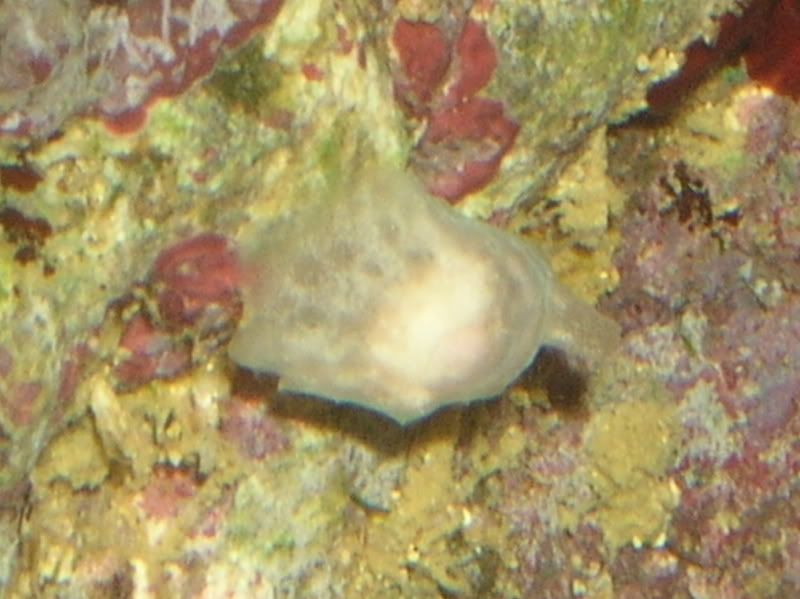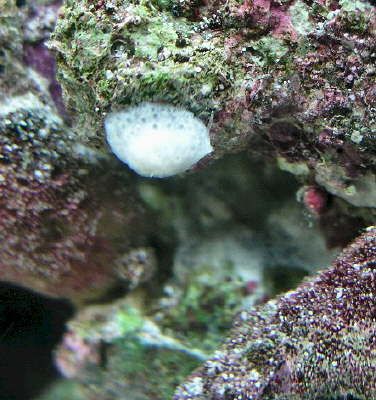


|
 |
|
|
#1 |
|
Registered Member
Join Date: Mar 2006
Location: Poulsbo WA
Posts: 646
|
ID Please
This guy has doubled in size since Saturday.
 Any ideas? Thanks. |
|
|

|
|
|
#2 |
|
RC Mod
 |
looks like a sponge, maybe pineapple sponge. Harmless, but can be a bit of a pest.
__________________
Sk8r Salinity 1.024-6; alkalinity 8.3-9.3 on KH scale; calcium 420; magnesium 1300, temp 78-80, nitrate .2. Ammonia 0. No filters: lps tank. Alk and cal won't rise if mg is low. Current Tank Info: 105g AquaVim wedge, yellow tang, sailfin blenny,royal gramma, ocellaris clown pair, yellow watchman, 100 microceriths, 25 tiny hermits, a 4" conch, 1" nassarius, recovering from 2 year hiatus with daily water change of 10%. |
|
|

|
|
|
#3 |
|
Registered Member
Join Date: Mar 2006
Location: Poulsbo WA
Posts: 646
|
Sorry Sk8r, I forgot to mention that it moves all over like a slug. It actually looks like what a snail might look like without its shell.
|
|
|

|
|
|
#4 |
|
Registered Member
Join Date: Mar 2006
Location: Poulsbo WA
Posts: 646
|
Went to the TBS site and found this:
 It's a white sea slug. Should I leave him in? |
|
|

|
|
|
#5 |
|
Registered Member
Join Date: Sep 2005
Location: Montclair, NJ
Posts: 1,046
|
It doesn't really look like a polyclad flatworm to me, as it seems to have quite a bit of bulk. I'd post this pic or a link to this thread in the Other Invertebrates forum here on RC. There are some super experts that frequent that board. They'll most likely have an ID for you.
|
|
|

|
|
|
#6 |
|
Team RC Member
 Join Date: Feb 2007
Location: Conroe, TX
Posts: 2,761
|
You will probably need to remove the animal and photograph it in a dish of water to get the details necessary for a positive ID. I've seen three different posts recently that appear to be this animal, but I don't think any of them ever got satisfactory answers. It may be a velutinid, but I don't have access to a tremendous number of photos of this family. It does look too "bulky" to be a flatworm.
Cheers, Don |
|
|

|
|
|
#7 |
|
Team RC Member
 Join Date: Feb 2007
Location: Conroe, TX
Posts: 2,761
|
By the way, I can't tell for sure, but it looks like the animal has a snail-like head. The Velutinidae are extremely varied, but in general, they are somewhat tent shaped, like a flatworm with a hump in the middle. Here is one resembles your animal, although I doubt it's actually the same species:
http://www.seaslug.info/display.cfm?id=13816 Don |
|
|

|
|
|
#8 |
|
Team RC Member
 Join Date: Feb 2007
Location: Conroe, TX
Posts: 2,761
|
|
|
|

|
|
|
#9 |
|
Registered Member
Join Date: Jan 2007
Location: Seven Hills, OH
Posts: 2,741
|
i have one also. it is in my overflow
__________________
Support Search and Rescue........GET LOST! |
|
|

|
|
|
#10 |
|
Registered Member
Join Date: Mar 2006
Location: Poulsbo WA
Posts: 646
|
Thanks for those links, Don. It looks a lot like Lamellaria diegoensis from Oregon, from that second link. I have not caught it munching on anything I want to keep around, but I'm going to keep an eye on his size.
It does have a snail-like head. He has a "snout," as my wife put it. He also glides quite easily over the rock. |
|
|

|
|
|
#11 |
|
Team RC Member
 Join Date: Feb 2007
Location: Conroe, TX
Posts: 2,761
|
You're welcome. If it is a velutinid, it will probably feed on colonial ascidians, as Bill Rudman notes in the links above. It probably has an internal shell that will look somewhat like a normal snail shell. If the animal dies, or if you decide to remove it, drop the animal in bleach for a few minutes and remove the soft tissue from the shell, then save the shell. The shell, along with your photos of the live animal, could be valuable to a researcher working on this family (and should enable a positive ID, assuming the animal has a name already).
Cheers, Don |
|
|

|
 |
|
|